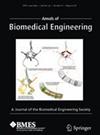Significance of Dynamic Axial Stretching on Estimating Biomechanical Behavior and Properties of the Human Ascending Aorta
Abstract
Contrary to most vessels, the ascending thoracic aorta (ATA) not only distends but also elongates in the axial direction. The purpose of this study is to investigate the biomechanical behavior of the ascending thoracic aorta (ATA) in response to dynamic axial stretching during the cardiac cycle. In addition, the implications of neglecting this dynamic axial stretching when estimating the constitutive model parameters of the ATA are investigated. The investigations were performed through in silico simulations by assuming a Gasser–Ogden–Holzapfel (GOH) constitutive model representative of ATA tissue material. The GOH model parameters were obtained from biaxial tests performed on four human ATA tissues in a previous study. Pressure–diameter curves were simulated as synthetic data to assess the effect of neglecting dynamic axial stretching on estimating constitutive model parameters. Our findings reveal a significant increase in axial stress (~ 16%) and stored strain energy (~ 18%) in the vessel when dynamic axial stretching is considered, as opposed to assuming a fixed axial stretch. All but one artery showed increased volume compliance while considering a dynamic axial stretching condition. Furthermore, we observe a notable difference in the estimated constitutive model parameters when dynamic axial stretching of the ATA is neglected, compared to the ground truth model parameters. These results underscore the critical importance of accounting for axial deformations when conducting in vivo biomechanical characterization of the ascending thoracic aorta.


 求助内容:
求助内容: 应助结果提醒方式:
应助结果提醒方式:


